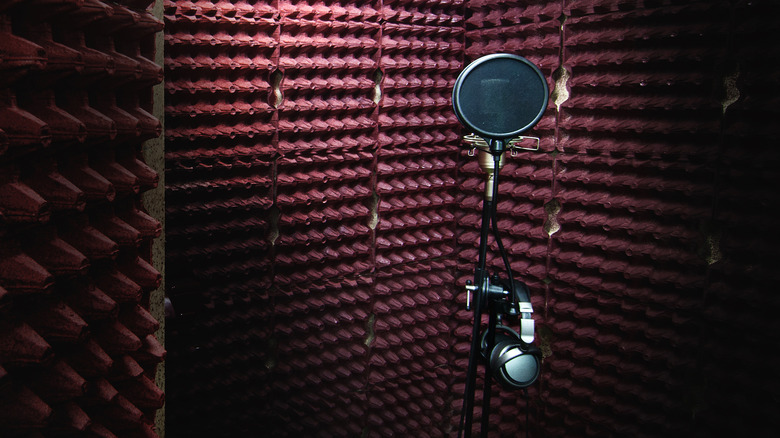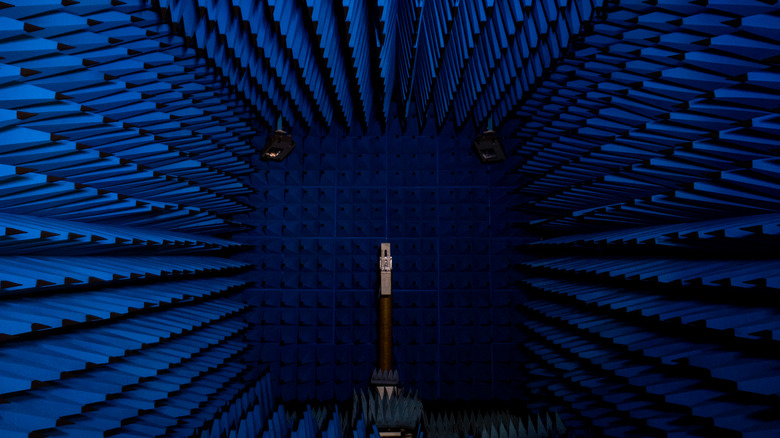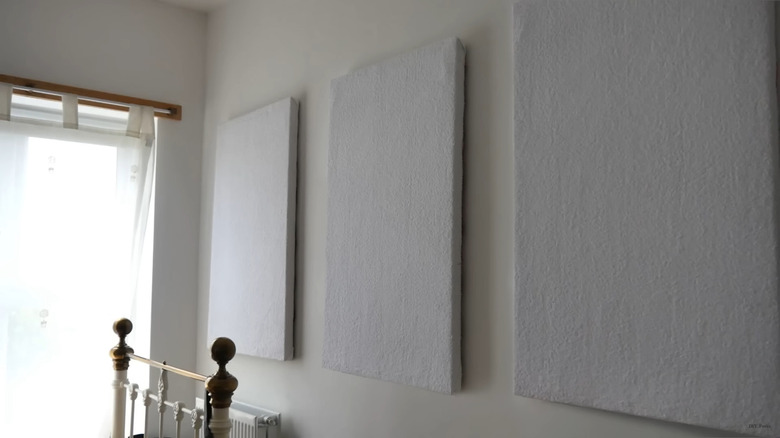Can You Really Use Empty Egg Cartons To Soundproof A Room On A Budget?
Acoustic treatments are niche products, to be sure, but if you need one, you need one. Home theaters, musicians with in-home studios, and anyone with a teenager will occasionally need to suppress sound. These products can be expensive, though, and budget-minded rock stars and parents of Machine Gun Kelly fans are always on the lookout for that magic product that solves all their soundproofing problems without requiring a second mortgage. For various reasons, people have occasionally become convinced that egg cartons can do this work, so we thought it would be worthwhile to walk you through why using one — or a thousand — can't actually soundproof anything. (It's possible that soundproofing isn't actually what you're looking for, but we'll come back to that.)
It's easy to imagine that companies selling acoustic treatments all have to hire a Chief Egg Carton Officer to deal with this issue, because it seems like they've all published refutations of the egg carton idea. Some have even commissioned laboratory studies of the efficacy — or lack of efficacy — of the containers. Take Riverbank Acoustical Laboratories, which has an entire program for testing novelty homebrewed acoustic treatments. The company evaluated pulp paper egg cartons using the ASTM International standard test method for sound absorption and sound absorption coefficients. No, really. This can tell you how "soundproof" a material is, though acoustic treatments are rarely for soundproofing. Musicians don't actually want to soundproof anything — what they want is to be able to hear their sound clearly. Meanwhile, home theater owners want to protect sound quality from unpleasant echoes and reverberations, and parents are actually looking to eliminate sound transmission altogether.
Egg cartons ain't nothing but a heartbreaker
Everything does something to sound. So what can egg cartons do for you in terms of acoustic absorption or diffusion? All the research basically agrees that the pulp paper boxes will absorb a little sound in a narrow high-frequency band. The most general read on this is from DIY recording blogger Emerson Maningo, who interprets research by Argentinian engineering professor Antonio Quintero-Rincon. According to Maningo, you might use egg cartons to absorb mid-range frequencies in "a very small control room (used for audio mixing)." But its limited range and low mass prevent it from doing much more absorption than that because a greater mass is required to convert sound energy to kinetic energy.
The shape of egg cartons might remind you of egg crate foam, and that structure exists primarily to diffuse sound, not to absorb it. Egg cartons won't suck up a significant amount of sound, but they will cause some very minor dampening through a process called diaphragmatic absorption and some very minor echo reduction via sound deflection (that is, reducing reverberation). Unfortunately, egg cartons don't do much of either. The problem is that they're so thin that most sound simply passes through them rather than being deflected and diffused to a noticeable extent. It's simply not worth the effort and notable aesthetic hit you'll take from hot-gluing your recycling to a wall. To paraphrase Edwin Starr: Egg cartons, what are they good for? Absolutely nothing. Say it again, y'all.
So what does work for sound absorption and diffusion?
Unless you're professionally recording music or your teen has started listening to Insane Clown Posse, you probably don't want to soundproof a room in a way that eliminates sound transmission altogether. It's a complicated and expensive commitment, but there are some ways to improve the quality of sound in a room through acoustic treatment. You have your "soundproof" curtains and blankets, vibration insulation pads, sound-absorbing panels, and the usual acoustic foam. But if you were considering egg cartons, you might be looking for something more cost-effective.
The de facto standard in DIY acoustic panels these days is Rockwool insulation, framed in wood and covered with an acoustically transparent fabric (don't let "acoustically transparent fabric" scare you — burlap works just fine). Rockwool, an extruded stone, is designed to have superior sound absorption qualities (in both its acoustic and "comfort" insulation products). Of course, you can go even cheaper. YouTuber DIY Perks makes some high-quality panels with old towels, as well as another version with upholstery foam and an aluminum angle frame. Speaking of YouTube, one of the most underrated channels in the acoustic space (and jet engines, and air conditioning, and more) is Tech Ingredients. They did exhaustive research and designed panels with a base of Rockwool and a covering of acoustic foam, which probably delivers the best results you can expect from a DIY project.


